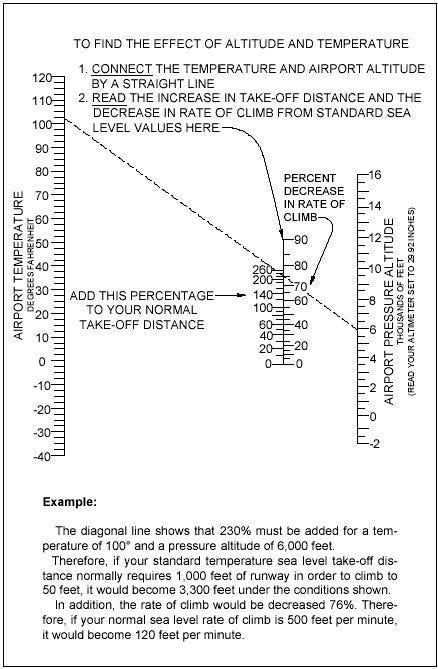DENSITY ALTITUDE
An invisible threat
For unprepared pilots, high density altitude—which occurs when the air has become thinner or less dense—could be fatal. Your engine's output is drastically decreased, your takeoff roll is lengthened, and your climb performance is adversely affected.
There are three factors that create high density altitude.
High altitude
High temperature
High humidity
It's easy to understand high altitude. The higher you are, the thinner the air is because there is less atmosphere above you. Because air expands at high temperatures, there is less air available in a given area for the engine and wings to use. When it comes to high humidity, as the amount of moisture in the air rises, less space is available for the air molecules in a given volume of atmosphere., leading to high density altitude.
Each of these will have an impact on your aircraft, but all three have the potential to significantly reduce its performance. Assume you are taking off from Anahim Lake, British Columbia (CYAA) at a height of 4600 feet Above Sea Level (ASL) on a humid 30 °C day. Your aircraft is already functioning as it would at 6400' ASL before you ever take off.
Density altitude in real life
Let's review the Standard Atmosphere and the distinction between pressure and density altitude to better comprehend how this relates in real life.
ICAO Standard Atmosphere
Temperature 15 °C at sea level
Sea level pressure of 29.92” Hg
Adiabatic Laps Rate of 1.98 °C/1000 ft
The air is a perfectly dry gas
Pressure altitude is the altitude indicated on your altimeter when it is set to 29.92, or your altitude under standard pressure.
Density altitude is pressure altitude corrected for nonstandard temperature.
This means anytime the air temperature you are flying in is not standard temperature, the air around your aircraft has a different density than it would under standard conditions and your aircraft performs differently.
Calculations
The most common way to calculate Density altitude is with a Koch chart.
If a chart is not available, the following calculation can be used.
Density altitude in feet = pressure altitude in feet + (120 x (OAT – ISA temperature))
It is also worth noting that if your Altimeter setting is below 29.92, this indicates an increase in density altitude which will decrease your aircraft’s performance
Things to consider
In many cases, density altitude is just one of the considerations in your flight planning. Often there is cooler weather, or your flight is at low altitudes and well within the performance envelope of your aircraft. But if it is hot, or humid, then density altitude jumps up the consideration list for your flight.
If you are one of the many pilots who live or often operate at high-elevation airports, then this is a regular consideration for you. In these cases, you may want to investigate how to minimize the effects of density altitude. While there is little you can do about your aircraft’s wing performance in high density altitude conditions, you can assist your engine.
On piston-powered aircraft, superchargers and turbochargers are used to either boost engine output or guarantee that the engine always has access to pressurized air. Essentially, these are air pumps that boost the engine's air supply and can lessen the effects of density altitude.
Turbochargers come in two different designs. A “boosted” turbo directly increases the power output of the engine. This means you have a more powerful engine, which is helpful at high altitudes. The impacts of high density altitude are still felt by boosted systems, thus flying the boosted version of an aircraft does not guarantee that it will handle every flying conditions.
A “turbo-normalized” system ensures that sea level performance is maintained at higher altitudes. This often increases the aircraft’s service ceiling. Turbo-normalized systems, while not immune, are well suited to handle the effects of density altitude.
Aircraft original equipment or upgrades, such as these, can greatly improve your safety margins.
No matter how your aircraft is configured, you still need to take high density altitude into account. Regardless of your engine, takeoff performance, and your weight & balance will still be affected.
When flying in high-density-altitude conditions, consider the following
Fly in cooler temperatures. Early morning and evening hours offer lower temperatures and often lower winds as well.
Check your weight and balance. Ideally, keep it below 90% of your maximum gross weight
During takeoff, if you have not reached 80% of your takeoff speed at the halfway point of the runway, abort the takeoff
Make shorter, more frequent legs
Density altitude is unavoidable, but with careful preparation and consideration, we can prevent a potentially fatal scenario.
Below is a video of a high density altitude accident from the AOPA Air Safety Institute.




